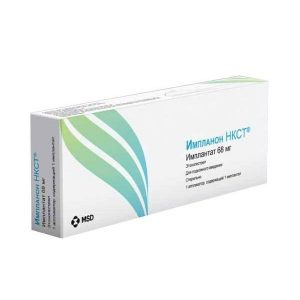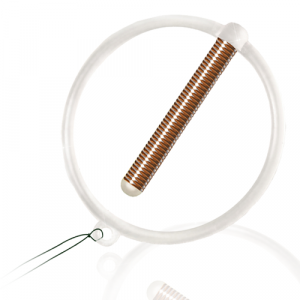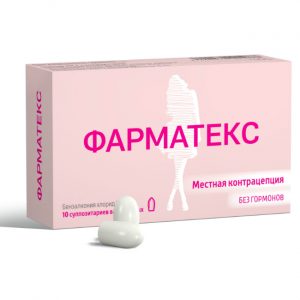Description
Latin name
Rigevidon 21 + 7
Packaging
In 1 blister, 21 tablets, in the second – 7. In a cardboard bundle 2 blisters.
Pharmacological action
Pharmacodynamics
Rigevidone is an oral monophasic combined estrogen-progestogen contraceptive.
When administered, it inhibits the pituitary secretion of gonadotropic hormones.
The contraceptive effect is associated with several mechanisms. As a progestin component (progestin) it contains a 19-nortestosterone derivative – levonorgestrel, which excels progesterone in the activity of the corpus luteum hormone (and a synthetic analogue of the latter – pregnin), and acts at the receptor level without preliminary metabolic transformations. The estrogen component is ethinyl estradiol. Under the influence of levonorgestrel, there is a blockade in the release of releasing hormones (LH and FSH) of the hypothalamus, inhibition of pituitary secretion of gonadotropic hormones, which leads to inhibition of maturation and the release of an egg ready for fertilization (ovulation). The contraceptive effect is enhanced by ethinyl estradiol. It maintains a high viscosity of cervical mucus (it makes it difficult for sperm to enter the uterine cavity). Along with the contraceptive effect, when taken regularly, it normalizes the menstrual cycle and helps to prevent the development of a number of gynecological diseases, including tumor nature.
Pharmacokinetics
Levonorgestrel is rapidly absorbed (in less than 4 hours). Levonorgestrel has no effect of the first passage through the liver. With the combined use of levonorgestrel with ethinyl estradiol, there is a relationship between the dose and the maximum plasma concentration. TCmax (time to reach maximum concentration) of levonorgestrel is 2 hours, T1 / 2 (elimination half-life) is 8-30 hours. (average 16 hours). Most levonorgestrel binds in the blood to albumin and SHBG (sex hormone-binding globulin).
Ethinyl estradiol is rapidly and almost completely absorbed from the intestines. Ethinyl estradiol has the primary effect of passing through the liver, TCmax is 1.5 hours, the half-life is about 26 hours.
When ingested, ethinyl estradiol is excreted from the blood plasma within 12 hours. The elimination half-life is 5.8 hours.
Ethinyl estradiol metabolism occurs in the liver and intestines. Ethinyl estradiol metabolites – water-soluble products of sulfate or glucuronide conjugation, enter the intestine with bile, where they undergo disintegration with the help of intestinal bacteria.
Both components (levonorgestrel and ethinyl estradiol) are excreted in breast milk. Active substances are metabolized in the liver, T1 / 2 is 2-7 hours.
excretion of levonorgestrel is carried out by the kidneys (60%) and through the intestines (40%) of ethinyl estradiol by the kidneys (40%) and through the intestines (60%).
Indications
Oral contraception, functional disorders of the menstrual cycle (including dysmenorrhea without an organic cause, dysfunctional metrorrhagia, premenstrual syndrome).
Contraindications
– Severe liver disease (including congenital hyperbilirubinemia – Gilbert, Dubin-Johnson and Rotor syndromes).
– Cholecystitis.
– The presence or indication of a history of severe cardiovascular and cerebrovascular diseases.
– Thromboembolism and predisposition to them.
– Malignant tumors (primarily breast or endometrial cancer).
– Tumors of the liver.
– Familial forms of hyperlipidemia.
– Severe forms of hypertension.
– Endocrine diseases (including severe forms of diabetes mellitus).
– Sickle cell disease.
– Chronic hemolytic anemia.
– Vaginal bleeding of unknown etiology.
– Bubble skid.
– Migraine.
– Otosclerosis.
– Idiopathic jaundice of pregnant women in history.
– Severe skin itching of pregnant women.
– Herpes of pregnant women.
– Age over 40 years.
– Pregnancy.
– Lactation (breastfeeding).
– Hypersensitivity to the drug.
Use caution with the drug in:
– Diseases of the liver and gall bladder.
– Epilepsy.
– Depression.
– ulcerative colitis.
– Uterine fibroids.
– Mastopathy.
– Tuberculosis.
– Kidney Disease.
– For diabetes.
– Diseases of the cardiovascular system.
– Arterial Hypertension.
– Impaired renal function.
– Varicose veins.
– Phlebite.
– Multiple sclerosis.
– Lesser Chorea.
– In adolescence (without regular ovulatory cycles).
Use during pregnancy and lactation
The drug is contraindicated during pregnancy and during lactation (breastfeeding).
Composition of
Tablets ethinyl estradiol + levonorgestrel
1 tablet contains: active substances: ethinyl estradiol 0.03 mg, levonorgestrel 0.15 mg,
excipients:
core: colloidal silicon dioxide – 0.275 mg magnesium stearate – 0.55 mg talc – 1.1 mg corn starch – 19.895 mg lactose monohydrate – 33 mg
shell: sucrose – 22.459 mg talc – 6.826 mg calcium carbonate – 3.006 mg titanium dioxide – 1.706 mg copovidone – 0.592 mg macrogol 6000 – 0.148 mg silicon colloidal dioxide – 0.146 mg povidone – 0.088 mg sodium carmellose – 0.029 mg
Placebo iron tablets
1 tablet contains: core: iron fumarate – 76.05 mg silicon colloidal dioxide – 0.5 mg croscarmellose sodium – 0.6 mg magnesium stearate – 1.2 mg povidone – 2.4 mg talc – 2.4 m potato starch – maize starch 2.1 mg – lactose monohydrate 10.2 mg – 24.55 mg
sheath: sucrose – Talc 38.295 mg – calcium carbonate 11.752 mg – titanium dioxide 5.103 mg – 2,226 mg kopolividon – 1, 124 mg of silicon dioxide colloidal – 0.24 mg of iron oxide red (E172) – 0.787 mg of povidone – 0.144 mg of macrogol 6000 – 0.281 mg of carmellose sodium – 0.048 mg
Dosage and Administration
Inside. 1 tab. per day, preferably at the same time of day.
If a woman in the previous cycle did not take a contraceptive and the doctor did not prescribe otherwise: 1st table. should be taken on the 1st day of menstruation, and continue taking pills for the 21st day. Then, therapy is recommended to continue taking reddish-brown tablets for 7 days, during which there is menstrual bleeding. After this, you should continue to take the next package containing 21 tablets. white, and then 7 tablets. reddish-brown color – without a break. Each cycle of admission begins on the same day of the week.
If a woman took a contraceptive in the previous cycle and in the previous package there were 21 tablets: the drug should be started after a 7-day break, on the 8th day.
The composition of the tablets of different colors is not the same. Therefore, the beginning and the correct sequence of administration – first 21 white tablets, then 7 reddish-brown tablets – are indicated on the package by numbers and arrows.
When switching to Rigevidon ® 21 + 7 with another contraceptive, should use the above scheme.
After childbirth or abortion: you can start no earlier than the 1st day of menstruation of the 1st biphasic cycle. The 1st biphasic cycle is usually shortened due to premature ovulation. If taking the drug begins already at the 1st spontaneous bleeding, the drug cannot successfully prevent premature ovulation, therefore, contraception may be unreliable in the first 2 weeks of the cycle.
If the pill was missed on time: the missed pill should be taken within the next 12 hours. In this case, there is no need to use additional methods of contraception. The remaining tablets are recommended to be taken at the usual time. If more than 12 hours have passed, you should take the last missed tablet (skipping the remaining unaccepted tablets) and continue taking the drug in normal mode. In this case, in the next 7 days it is necessary to apply additional methods of contraception (barrier methods, spermicides).
This does not apply to reddish-brown tablets, as they do not contain hormones.
For therapeutic purposes: the dose of the drug and the regimen are selected by the doctor for each patient individually.
Side effects
The drug is usually well tolerated.
Possible transient side effects that spontaneously pass: nausea, vomiting, headache, breast engorgement, weight and libido changes, mood changes, acyclic spotting, in some cases – edema of the eyelids, conjunctivitis, visual impairment, discomfort when wearing contact lenses (these phenomena are temporary and disappear after cancellation without the appointment of any therapy).
With prolonged use, chloasma, hearing loss, generalized itching, jaundice, cramps of the calf muscles, and an increase in the frequency of epileptic seizures can very rarely occur. Hypertriglyceridemia, hyperglycemia, decreased glucose tolerance, increased blood pressure (BP), thrombosis and venous thromboembolism, jaundice, skin rashes, changes in the nature of vaginal secretion, vaginal candidiasis, increased fatigue, and diarrhea are rare.
Drug Interaction
Barbiturates, certain antiepileptic drugs (carbamazepine, phenytoin), sulfanilamides, pyrazolone derivatives are able to enhance the metabolism of steroid hormones included in the drug.
Decreased contraceptive efficacy may also be observed when co-administered with certain antimicrobial agents (including ampicillin, rifampicin, chloramphenicol, neomycin, polymyxin B, sulfonamides, tetracyclines), which is associated with changes in microflora.
When used concurrently with anticoagulants, coumarin or indandione derivatives, additional prothrombin index determination and anticoagulant dose modification may be required.
When using tricyclic antidepressants, maprotiline, beta blockers may increase their bioavailability and toxicity.
The use of oral hypoglycemic agents and insulin may require a change in their dose.
When combined with bromocriptine, its effectiveness decreases.
When combined with drugs with potential hepatotoxic effects, such as dantrolene, there is an increase in hepatotoxicity, especially in women over 35 years of age.
Rigevidone should be used with caution in combination with the above medicines.
Overdose
Cases of toxic effects due to overdose are unknown.
Storage conditions
The drug should be stored at a temperature of 15 ° to 30 ° C.
Expiration
5 years.
tablet dosage form
Formulation
tablets




